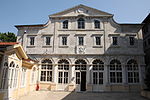Ayakapı

Ayakapı (Turkish: "The Gate of the Saint", "The holy gate") (the toponym comes from the Turkish word Aya, derived from pronunciation of the Greek word ἁγἰα, mean. "female Saint" and the Turkish word kapı, mean. "gate") is a quarter of Istanbul, Turkey. It is part of the district of Fatih, inside the walled city, and lies on the shore of the Golden Horn. During the Byzantine era, it was named ta Dexiokratiana or ta Dexiokratous in Greek, after the houses owned here by a certain Dexiokrates. Its modern name comes from a church dedicated to Saint Theodosia which, according to Petrus Gillius, stood near the gate. In Ayakapı lies one of the most important surviving Byzantine buildings of the historical peninsula, the Gül Mosque. Moreover, in 1582 the Ottoman architect Sinan built here a Turkish bath, the Ayakapı Hamamı. This structure is currently used as a storage for timber.
Excerpt from the Wikipedia article Ayakapı (License: CC BY-SA 3.0, Authors, Images).Ayakapı
Şair Nefi Sokağı, Istanbul
Geographical coordinates (GPS) Address Nearby Places Show on map
Geographical coordinates (GPS)
| Latitude | Longitude |
|---|---|
| N 41.026666666667 ° | E 28.9565 ° |
Address
Gül Cami
Şair Nefi Sokağı
34083 Istanbul
Türkiye
Open on Google Maps








